24 April 2021
Posted by Beth McKeeman
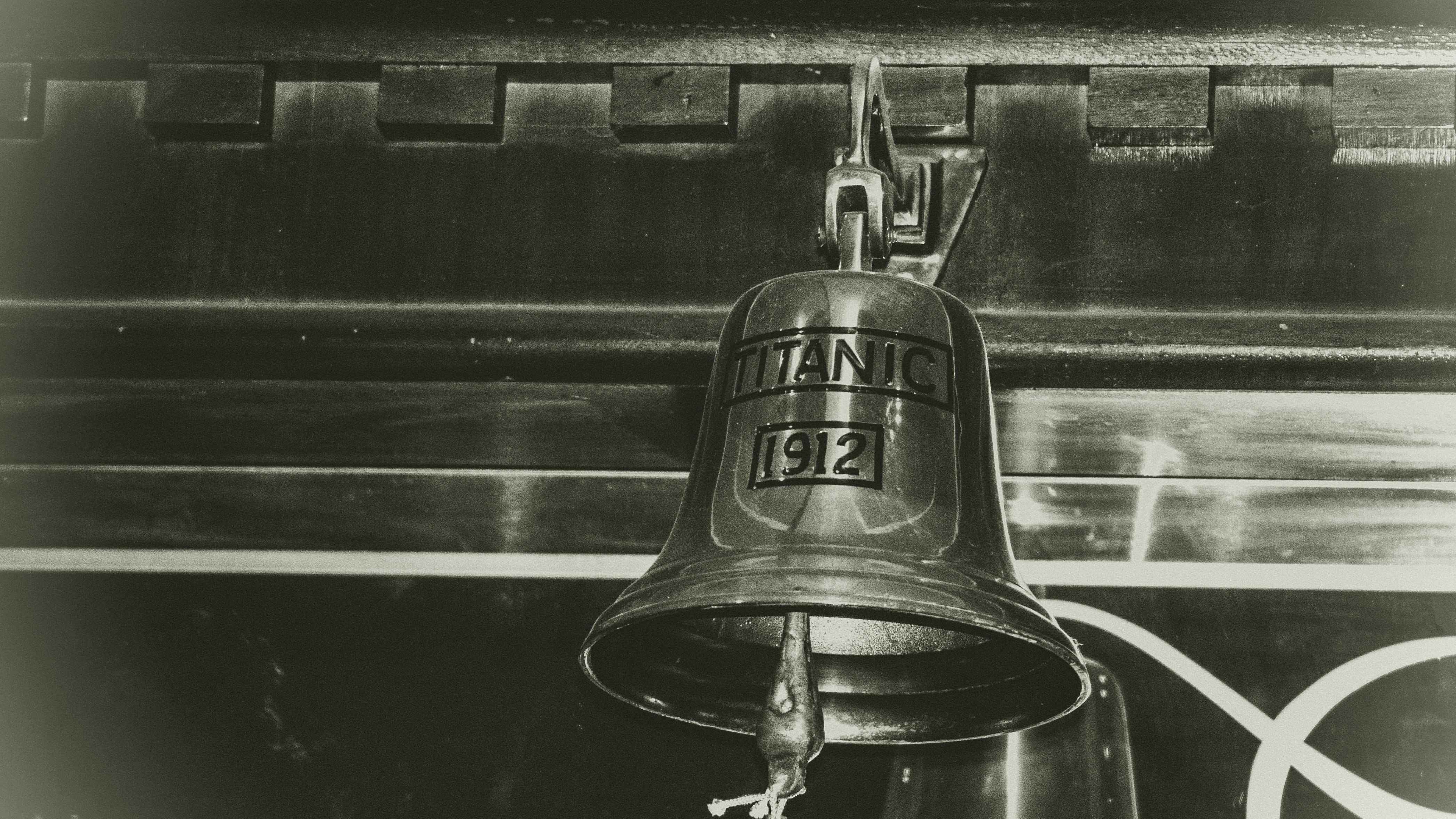
Titanic Start to a New Term
Numbers – 13
Sadly we’re currently down to a single group, but we don’t let that deter us as we meet back in person; full steam ahead.
We’ve moved home to the new MAST Mayflower Studio location and due to the 1 metre precaution rule are spilling out of the room into the bar.
Personally, I only attended one session before we went into lockdown and there have been a few new faces join us since so it’s been jarring to see everyone outside the tiny boxes I’ve come to know them through.
As we get use to the new space, we started out with a theme that should be recognisable to everyone who’s grown up in Southampton – the Titanic.
As many of us know, the Titanic launched its maiden voyage from Southampton in 1912. Susmita lead us through the facts and timeline of this historic ship as we began to plan out a character before writing a diary extract.
The ship was built in Belfast, Northern Ireland, before moving down to Southampton for its official launch. Many of the crew were from Southampton, about 4 out of 5 listing Southampton as their address, meaning that of the 688 crew that died, over 500 were from our home city. There were more who worked on the ship before it launched. A story of my grandmother’s is that a family friend was one of the people putting the finishing touches on the Titanic. They were working up to the very minute of boarding, at which point they were hastily told to get off. So quick was he to leave that he left his lunch box. At the time he shrugged off the misfortune, thinking he’d be able to reclaim it upon the Titanic’s return, however as we all now know that never happened and as far as I know his lunchbox has never been recovered from the wreck.
He could expect his lunchbox to return because no one expects a ship to sink on her maiden voyage, that’s not what ships are designed to do, but there was even more hype surrounding the Titanic. The biggest ship yet, the so-called unsinkable, with plans to cross the Atlantic in a record-breaking 5 days, earning the Blue Riband award. She was a dream ship.
Ironically the impossible was reserved for the only boat to come to her aid, RMS Carpathia. 58 miles away, a journey that would take over four hours to make, upon receiving the distress call at 12.10am the night of April 15, Captain Rostron turned around and set full steam ahead. The ship was designed to achieve 14 knots (the boating equivalent of mph) however by pushing more coal and cutting hot water and heating so all steam went to the engines the 4 hour journey was completed in 3 and a half hours as their speed climbed to an unheard of 17 knots.
The Carpathia is the reason an estimated 710 people survived the sinking of the Titanic. Even with lifeboats, that far out in the bitter Atlantic ocean with ice surrounding them and not dressed for the cold, the exposure would have killed them.
As is often quoted, the Titanic didn’t have enough lifeboats for its approximately 2223 occupants, only having capacity for about half that number. It was with these facts and the dates and times of the sailing and sinking that we forged out diaries. Some talked about the journey to Southampton and boarding the ship, the division between first class and third. Others talked about the harrowing nature of the night the iceberg hit.
What’s perhaps even more tragic about Titanic’s tale, as Ruhaan pointed out, is that simulations have been run which suggest that had they just stayed the course and ran the iceberg straight on instead of turning and scraping against it, the ship likely would have survived the encounter. It would have been like standing on an egg, possible to do so on the point where physics spreads the force throughout the shell. Instead the greed and pride of White Star Line got in the way. They took a riskier higher latitude route to save time and make what would be a historically fast crossing, placing them in the path of icebergs, and didn’t want to scratch their shiny new ship by plowing it into an iceberg, so instead they turned. Boats, however, are slow to manoeuvre, and this sealed Titanic’s fate.
There are so many stories associated with the Titanic, of bad decisions, of fear, of loss, of heroism, of love. Creating fictional diaries of historic events allows us to explore all this.
Join us for the rest of this term as we continue to explore writing in our new space!
Amelia's foreboding
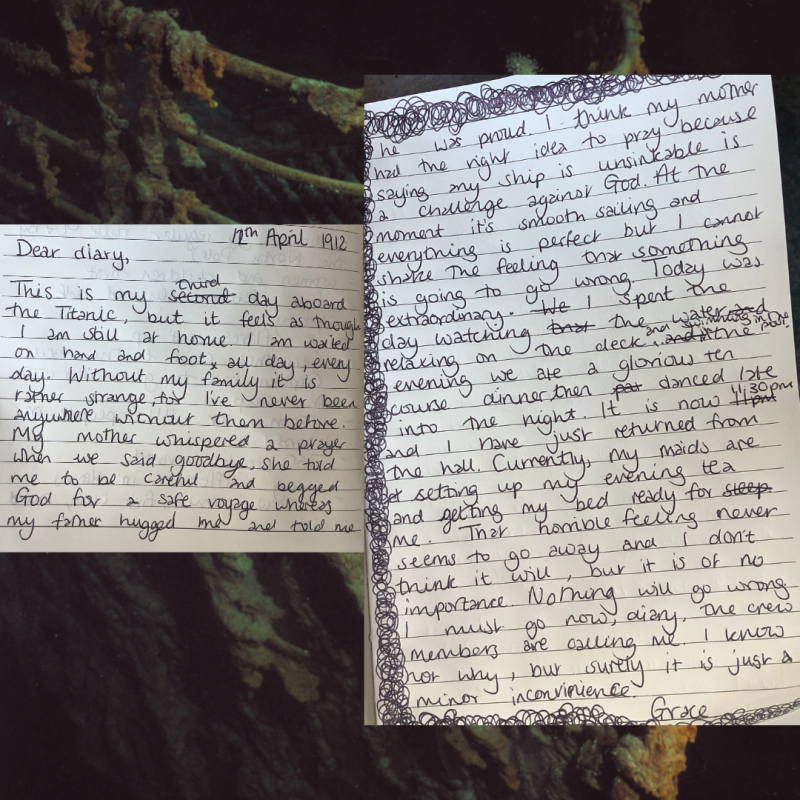
Conrad's final words of a crew member

Ella's reflections of the incident
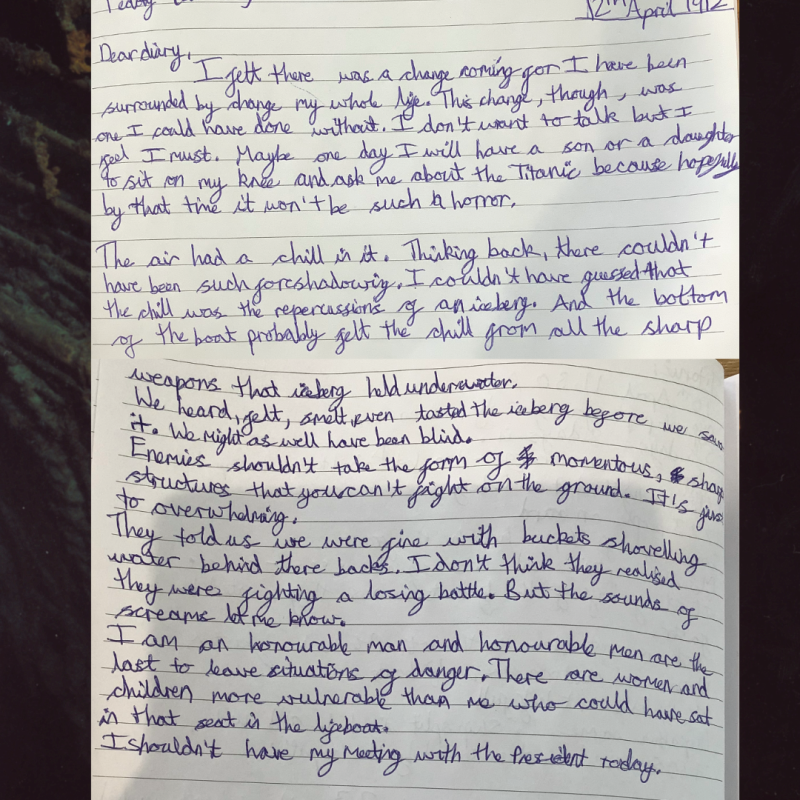
Gene's first class child arrival
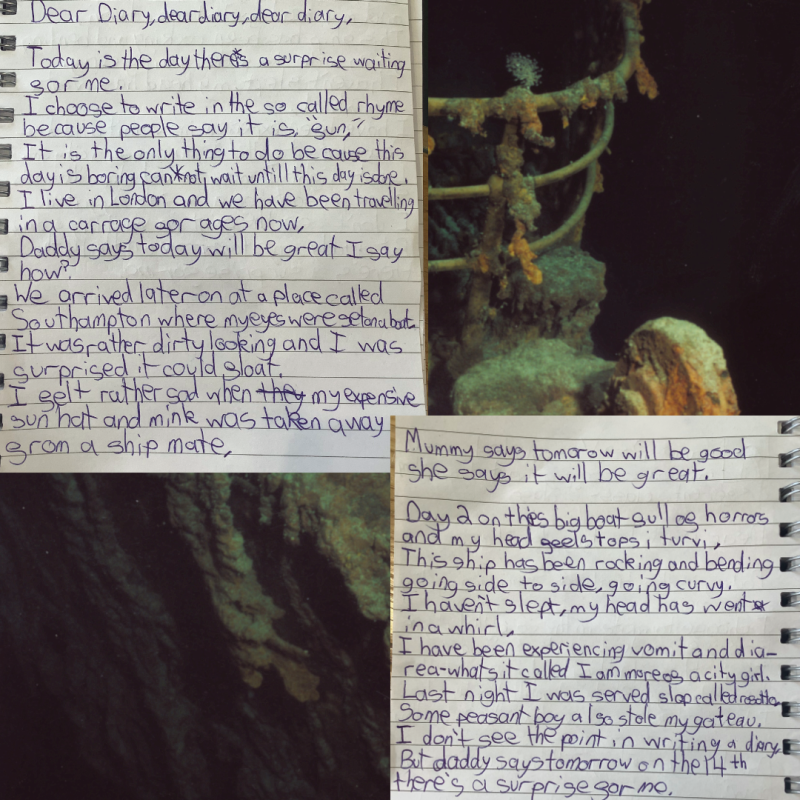
Ruhaan's first class child excitement
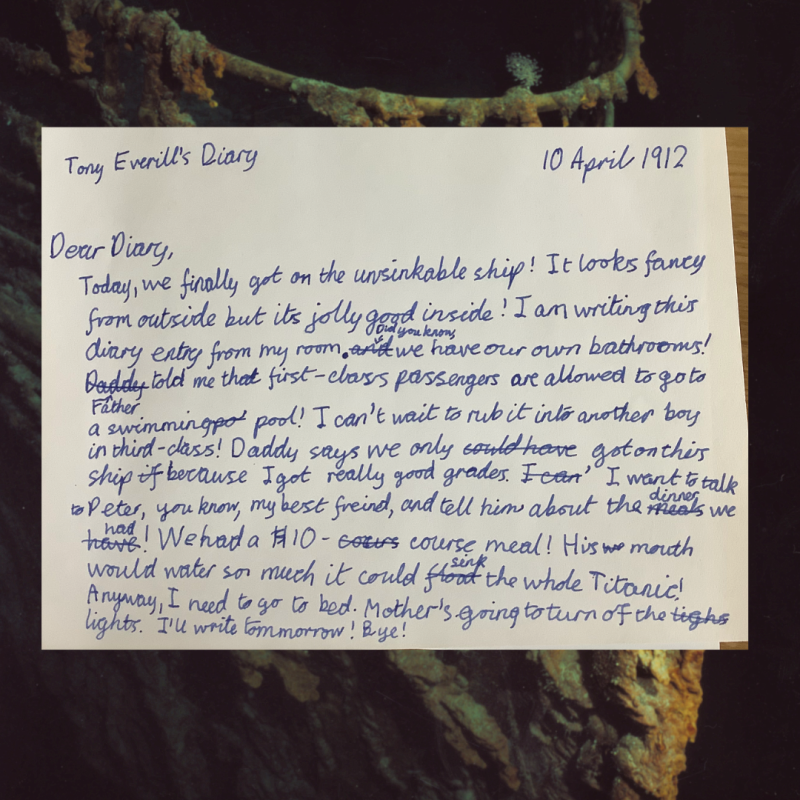
Shani's third class daughter
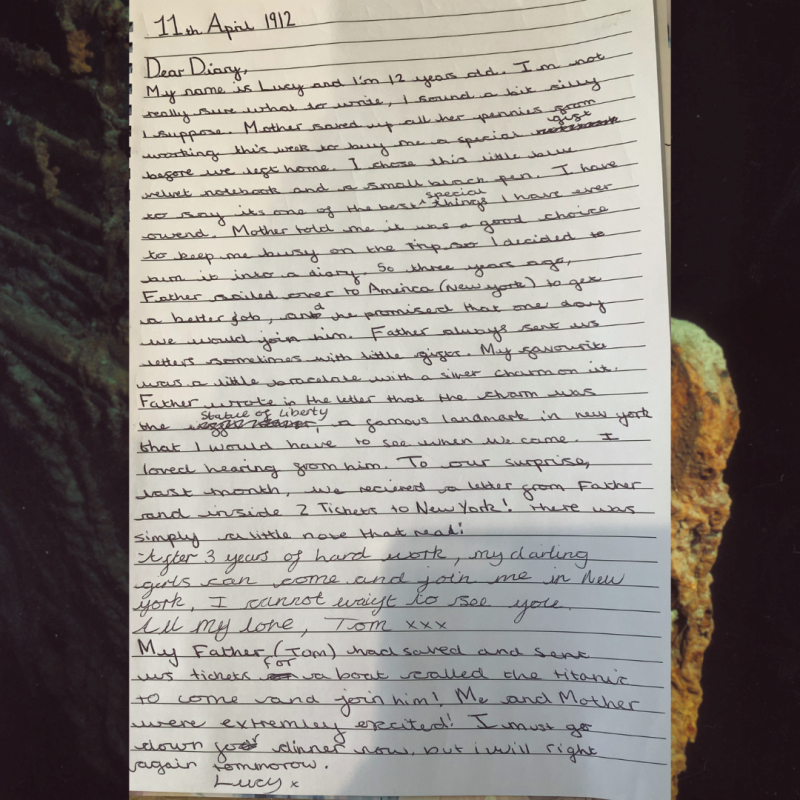
Archive
Junior & Young Writers Week 3: Return From The Magical World
Junior & Young Writers Week 2: African Mythology
Problems, Problems, Problems...
Cautionary Tales & Christmassy Opening Lines
You've Gotta Have Pace, Pace, Pace
Junior & Young Writers Week 1: Alien Encounters
Junior & Young Writers: Week 5 - Play on Words Pt. 2
Junior & Young Writers: Week 11 - end of term showcase [build a bard workshop]
Junior & Young Writers: Week 10 - Greek Theatre - chorus stories
Junior & Young Writers: Week 9 - Greek Origin Stories - Spring
Rubber Ducks & Writing Festivals
Junior & Young Writers: Week 7 - Greek Hero Stories [the 12 labours of Hercules]
Junior & Young Writers: Week 12 [Wild Words] - Stuff & Things
Junior & Young Writers: Week 11 [Wild Words] - World Building 2
Junior & Young Writers: Week 10 [Wild Words] - World Building
Junior & Young Writers: Week 9 [Wild Words] - Mystery & Choose Your Own Adventure
Junior & Young Writers: Week 8 [Wild Words] - Spooky Sequels & Potion Poems
Junior & Young Writers – Week 10 (Writers’ Inspiration) – Final Showcase
Junior & Young Writers – Week 9 (Writers’ Inspiration) – Editing & Performance Tips
Junior & Young Writers – Week 8 (Writers’ Inspiration) – Cuteness
Time goes on by Tavinder Kaur New
Junior & Young Writers – Week 7 (Writers’ Inspiration) – Natural Solutions
Junior & Young Writers – Week 6 (Writers’ Inspiration) – The Language of Fruit and Veg
Junior & Young Writers – Week 5 (Writers’ Inspiration) – Adventures In Space
Tinklebobs and Bedraggled Angles
Junior & Young Writers – Week 4 (Writers’ Inspiration) – Our Environment
Fortune Tellers & Future Letters
Junior & Young Writers – Week 3 (Writers’ Inspiration) – Home
Young Writers - Week 10 (The Art of Writing) – Final Week Showcase
Junior Writers - Week 10 (The Art of Writing) – Final Week Showcase
Young Writers – Week 9 (The Art of Writing) – Choose Your Own Adventure
Junior Writers – Week 9 (The Art of Writing) – Choose Your Own Adventure
Young Writers – Week 8 (The Art of Writing) – Sequel Stories
Junior Writers – Week 8 (The Art of Writing) – Sequel Stories
Young Writers – Week 7 (The Art of Writing) – Picture Prompts
Junior Writers – Week 7 (The Art of Writing) – Picture Prompts
Young Writers - Week 6 (The Art of Writing) - Script-writing & Dialogue
Junior Writers - Week 6 (The Art of Writing) - Script-writing & Dialogue
Junior Writers – Week 5 (The Art of Writing) – Poetry
Young Writers - Week 5 (The Art of Writing) - Poetry Potions
Edward The Martyr - A Competition!
Mood Boards and Postcards from Space
Young Writers - Week 3 (The Art of Writing) - PLOT
Junior Writers - Week 3 (The Art of Writing) - PLOT
Moomin Stories and Hollywood Pitches
Young Writers - Week 2 (The Art of Writing) - Genre & Setting
Junior Writers - Week 2 (The Art of Writing) - Genre & Setting
Prompts, Dialogues, and Cliché
Story Structure Part One: Exposition and Beyond...
Young Writers - Week 1 (The Art of Writing) - Character
Junior Writers - Week 1 (The Art of Writing) - Character
Young Writers - week 4 - Nature Writing [animals & wildlife]
Junior Writers - week 4 - Nature Writing [animals & wildlife]
Young Writers - week 3 - Nature Writing [trees/plants/flowers]
Junior Writers - week 3 - Nature Writing [trees/plants/flowers]
Young Writers - week 2 - 'fractured fairy tales'
Junior Writers - week 2 - 'fractured fairy tales'
Young Writers - week 1 - 'from deep inside a forest'
Creating Communities through Writing
WORDCUP - Hounsdown Session #6
Making pillows in a house full of feathers
WORDCUP - Hounsdown Session #5
Exploring home – a place, person, house
WORDCUP - Hounsdown Session #4
Stories From Our Streets at the Abbeyfield Wessex Society Reminiscence Session at Poole Library
What Do You Really Mean? Writing Dialogue for Scripts
WORDCUP - Hounsdown Session #3
Character Building & Murder Mysteries
Going inside – from a spark to a story
WORDCUP - Hounsdown Session #2
Maybe I Can Be Invisible After All... Monologues
Creative Writing: Fun Facts, Diverse Voices and Different Perspectives
Writing Competition - Stories From Our Streets
Stories From Our Streets Community Activity Pack
Thinking in-quiet, after the fire
Found Cities, Lost Objects: Women in the City Curated by Lubaina Himid CBE
Ekphrastic Jukebox - Writing to Music
ArtfulScribe LitFest Community Showcase 2023
Young writers exercise their creative power
Writing to The Sorcerer's Apprentice
The Mousetrap - Mayflower Young and Junior Writers Investigate Mystery!
Stories From Our Streets Launch!
Interview: In Conversation with Dr Victoria Leslie
The Missing Farmer/ Blackout Poetry & DADA
Exploring this wonderful World
Using props to create characters/ working as a writing room
Stories of the Dust and Character Questions
Storytelling and Escalation or Rising Action
Junior Writers Club Acrostic Poem
Notes on Intention for MAST Collective - Year 3 - Facilitation Focus
Earthquakes & Dominoes - MAST Collective Blog #4
SUPER MARIO AND POP CULTURE POEMS
Receptionists & Inky Voids - MAST Collective Blog #3
Saying No and saying YES on National Poetry Day!
There's a Dragon in the Wardrobe...
House Warming Party (The Mortifying Ordeal of Being Known) - MAST Collective Blog #2
Intern Blog 5 - The Publishing Process
POEMS TO SOLVE THE CLIMATE CRISIS
On The Streets With Theresa Lola
Intern Blog 4 - The Internship Journey
NEW DIRECTIONS, STARTING SMALL - THE ORWELL YOUTH PRIZE
LIGHTHOUSES, HOPE AND METAPHORS
on workshop and transformations: frogs, lions, and the duck that becomes a larder...
Poetry Ambassadors - Interview with April Egan
Intern Blog 1 - Finding a Voice
World Poetry Day: Fluffypunk and the Invisible Women
On Being a Writer: A Conversation by Beth Phillips & Sam Morton
Poetry Ambassadors - Interview with Kaycee Hill
UNHEARD VOICES: INTERNATIONAL WOMEN'S DAY, AND STORIES OF CONFLICT













